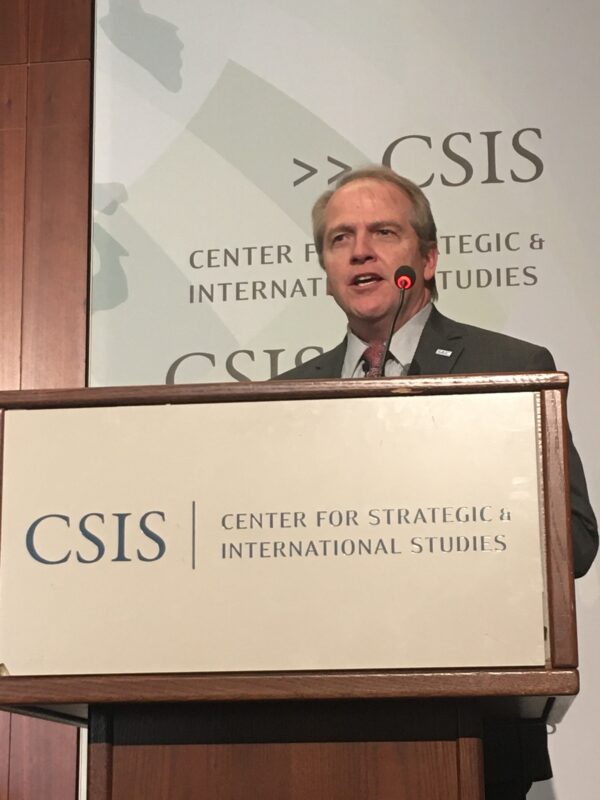
The emphasis on digital transformation is bringing advanced technologies and concepts such as model-based systems engineering to the forefront of government modernization efforts, and Science Applications International Corp. is putting mission execution before specs when evaluating customer needs.
That’s according to Jim Scanlon, the company’s executive vice president and general manager of the Defense Systems Customer Group, who spoke Jan. 23 at the Center for Strategic and International Studies’ “Main Street Defense Series: Innovative Solutions From New Sources” in Washington, D.C., about SAIC’s role in delivering integrated solutions that can be sustained and implemented overtime to help solve defense problems.
As a $6.5 billion government services integrator, SAIC works in the defense, national security and civilian markets to provide technical and engineering services, enterprise IT and supply chain management. Scanlon leads strategy, business development and program execution for about $2.9 billion in support to the U.S. Army, U.S. Navy, U.S. Marine Corps and the Defense Logistics Agency.
As part of the company’s technical and engineering services portfolio, 70% of SAIC’s workforce sits side by side with customers in the customers’ environment, working hand in hand to solve problems, rapidly prototype, model and simulate solutions in laboratories, simulators and emulators.
“We do that primarily at all of the Navy Warfare Centers and as well as the research development centers in the Army,” Scanlon said.
And as a services integrator, SAIC doesn’t make technology. To find solutions that apply to the defense mission and forecast what it needs, the company reviews the National Defense Strategy, evaluates where the military wants and needs to go and anticipates how to solve those problems. Plus, many of SAIC’s employees have served in uniform and have that mission insight.
“Our focus was on solving the problem,” Scanlon said. “I’m not going to worry about who makes what; I’m going to look at niche firms, I’m going to look across the globe, I’m going to evaluate technologies. My focus is going to be on the solving of the problem, and bringing the best solution forward.”
The company does so by understanding the customer, staying focused on the mission and having the domain expertise to evaluate solutions and put them in the proper context. This is important as SAIC takes a technology from a product provider and puts it in an integrated solution to produce an intended outcome for a customer.
And this relationship with customers and industry partners is playing a big part in digital transformation, modernization and readiness, especially amid a movement to get the acquisition side of defense closer to operations.
“There’s a fundamental need across the board based on the National Defense Strategy to push technology quicker and leverage all of the capabilities,” Scanlon said. That includes advanced experimentation, fail-fast and try-fast approaches.
“For us, having that understanding and insight is really important to be able to do that,” he added.
But one of the challenges in the acquisition process is remaining heavily focused on the technical specifications rather than mission execution.
Contractors sift through hundreds of pages of specifications and work to meet certain requirements, and at times, solutions are built that don’t achieve what the system was intended to do.
Scanlon argued there is a fundamental difference in stepping back and evaluating the intended mission and outcome of the specifications, looking at the parameters from cost/schedule performance to do trade-space analysis.
“In many cases, the acquisition hasn’t gotten to that point yet,” he said. “That ability to think of it from the mission execution side as opposed to the technical specification side is an evolution process.”
From a digital transformation perspective, Scanlon referred to what the Navy is trying to with the digital twin architecture — the idea of using a computer-based model of a mechanical or electrical system, in this case, a complex military system. So, if the Navy were to make a machine, it could also make a computerized replica of that machine to understand maintenance, know if the system wasn’t working properly and why, etc.
“It fundamentally gets down to — with model-based system engineering, mission engineering — that ability to leverage the power that computers, the digital environment, the virtual synthetic analysis, for me to be able to do those evaluations earlier, sooner, faster, to be able to make those trades . . . I think is really critical,” Scanlon said.
And this current digital transformation evolution is making it possible to do that — the technologies are available that enable organizations to bring these types of capabilities forward.
However, it’s costly and time consuming to develop and deploy those solutions, especially if the outcome produced isn’t the intended solution.
“But if I can do that in model-based engineering, to do those trades and evaluations and so forth, I can enhance that requirements, trade-off and analysis,” Scanlon said.
And according to Scanlon, that’s the cornerstone of what SAIC does.
“It’s in that element of architecture analysis, trades, combinatorial analysis and requirements pay off. Being able to look at technologies in that context is really important,” he added.

